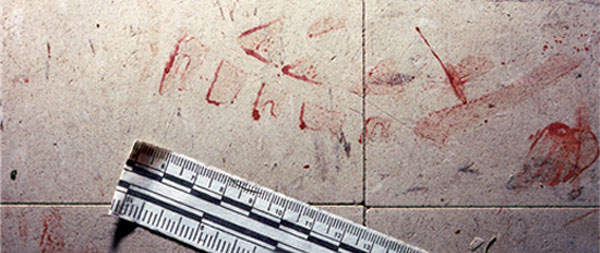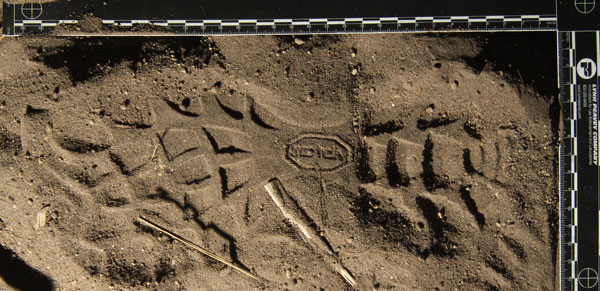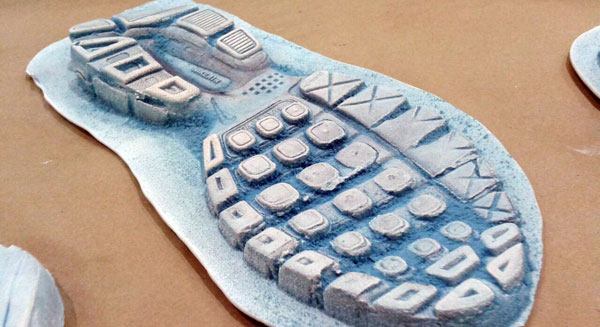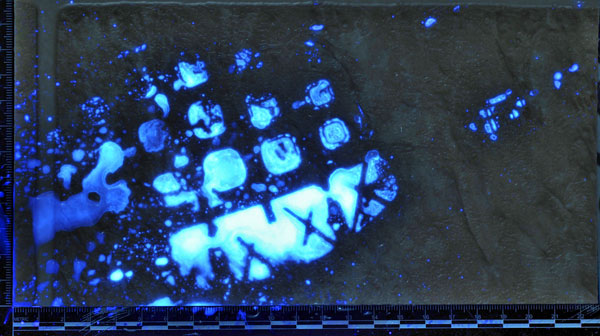How It’s Done
Evidence that May be Examined
Footwear and tire tracks can be deposited on almost any surface, from paper to the human body. Prints are divided into three types: visible, plastic and latent.
A visible print is a transfer of material from the shoe or tire to the surface. This type can be seen by the naked eye without additional aids. For example, bloody shoe prints left on flooring or tracks left by muddy tires on a driveway.

Bloody shoeprints are visible on tile flooring. (Courtesy of John Black, Ron Smith & Associates)
A plastic print is a three-dimensional impression left on a soft surface. This includes shoe or tire tracks left in sand, mud or snow.

Plastic shoeprint left in sand. (Courtesy of Aubrey Askins, Tacoma Police Department)
A latent print is one that is not readily visible to the naked eye. This type is created through static charges between the sole or tread and the surface. Examiners or investigators use powders, chemicals or alternate light sources to find these prints. Examples include shoeprints detected on a tile or hardwood floor, window sill, or metal counter, or tire tracks detected on road surfaces, driveways or sidewalks.

Dust impression left on a masonite surface, illuminated with oblique lighting. (Courtesy of Scott Campbell, Ron Smith & Associates)
How Samples are Collected
Examiners use several methods for collecting footwear and tire track evidence depending on the type of impression found. For impressions in soil, snow or other soft surfaces, casting is the most commonly used collection method. For imprints, examiners generally try to collect the entire object containing the imprint, such as a whole sheet of paper or cardboard with a shoe print. When that is not possible, for instance, if the print is on a bank counter, the examiner would use a lifting technique to transfer the imprint to a medium that can be sent to the laboratory.

Casts are created of footwear impressions to preserve them and allow for comparison and analysis. (Courtesy of NFSTC)
As with any evidence found at a crime scene, shoeprints and tire tracks must be properly documented, collected and preserved in order to maintain the integrity of the evidence. Impression evidence is easily damaged, so steps must be taken to avoid damage to the evidence. This includes securing and documenting the scene prior to collecting any evidence.
In the case of impression evidence, general photographs of the evidence location in relation to the rest of the scene are taken, along with high-resolution images of the individual imprints or impressions. Examiners may use alternate light sources or chemical enhancers to capture as much detail as possible, especially with latent imprints.
Properly photographing impressions is crucial. Since there is only a slight difference between different shoe sizes, if the photographs are not taken at a 90° angle to the impression, then the true size cannot be produced in order to compare to the actual shoe.
Whenever possible, impression evidence is collected as is and submitted to the laboratory for examination. For shoeprints and tire tracks that cannot be picked up, various lifting techniques are used to recover the evidence. These include:
• Adhesive lifter - a heavy coating of adhesive lifts the imprint from smooth, non-delicate surfaces such as tile or hardwood floors, metal counters, etc. It is usually used in conjunction with fingerprint powders.
• Gelatin lifter - a sheet of rubber with a low-adhesive gelatin layer on one side that can lift prints from almost any surface, including porous, rough, curved and textured surfaces. It is less tacky and more flexible than an adhesive lifter, allowing it to pick up a dusty shoeprint on a cardboard box, for example, but not tear the surface of the box.
• Electrostatic dust-print lifting device - a tool that electrostatically charges particles within dust or light soil, which are then attracted and bonded to a lifting film. This method is best for collecting dry or dusty residue impressions on almost any surface, even the skin of a cadaver.
Any plastic, or three-dimensional, footwear or tire impressions can be collected by casting. Casting uses a powdered stone material, such as dental stone, that can be mixed with water and poured into the impression. When it dries, this method creates a three-dimensional model of the impression.
Imprints and impressions may be further processed to enhance or bring out additional minute details. For example, a digital enhancement program such as Adobe Photoshop® can be used to improve the quality of a photographed tire track. Fingerprint powders and chemical stains or dyes can enhance image color or increase the contrast against the background. This enables lifted or casted evidence to be photographed or scanned.

A faint bloody shoe print on linoleum is enhanced by treatment with a chemical, BLUESTAR®, to allow a more detailed photograph to be taken of the evidence. (Courtesy of Erik Savicke, Boston PD)
Comparison samples are usually taken from suspects or suspect vehicles. Shoe samples should be packaged to avoid cross-contamination and tire samples should remain on the vehicle.

A reference print from a tire is captured by inking the tire and driving over paper. (Courtesy of John Black, Ron Smith & Associates)
Learn more about tire exemplar collection ▸
Who Conducts the Analysis
Evaluation and comparison of impression evidence should be performed by a well-trained footwear and tire track examiner. Typically these professionals have received extensive training on footwear and tire manufacturing, evidence detection, recovery, handling and examination procedures, laboratory and photography equipment and procedures, courtroom testimony and legal issues, and casework.
The Scientific Working Group on Shoeprint and Tire Tread Evidence (SWGTREAD) has a published standard that discusses the minimum qualifications and training for footwear/tire track examiners. Additionally, the International Association for Identification (IAI) offers a recommended course of study for footwear and tire track examiners that takes participants through more than 550 hours of training. The IAI also certifies footwear (but not tire track) examiners.
How and Where the Analysis is Performed
Detection, documentation, photography, and collection of imprints and impressions occur in relation to crime scenes of many types. Analysis of impression evidence is typically performed at a public crime laboratory or private laboratory by experienced examiners.
Evidence Submission and Examination
Ideally, the suspect’s shoes and/or tires are submitted to the lab along with the collected evidence. Examiners will use the submitted shoes and/or tires to make test standards, impressions of a known source, which can then be compared to the collected evidence. This is usually done using transparency overlays or side-by-side comparisons.
For example, in a case from Florida, a bloody shoe print was found on the carpet in the home of a murder victim. The print indicated that there was a hole in the shoe that left the print. Investigators collected and made test prints of the shoes from individuals known to be at the scene near the time of the murder. Footwear examiners were able to identify the perpetrator by overlaying the bloody shoeprint from the crime scene with the test print made from the suspect’s shoe.
In some cases, an investigator may be asked to submit shoes or tires of other individuals for exclusion purposes, such as from a cohabitant of a home or from a first responder to a crime scene.
Tools and Techniques
During the examination and comparison, examiners use tools such as dividers, calipers, special lighting and low magnification. Examiners measure the various elements within the tread design as well as the length and width of the impressions, and then compare those measurements to what is seen in the crime scene print or impressions. Low magnification and special lighting are sometimes used to determine if various characteristics are accidental or something that was created during the manufacturing process.
Examiners perform side-by-side comparisons by placing the known shoe or tire alongside the crime scene print so that corresponding areas can be examined. Test prints are also compared to the crime scene print. Digital images on double or triple computer monitors can also be used during the comparison.
Resources and References
Investigators or examiners often use searchable databases containing reference files of shoe outsoles and tire treads to determine the brand/model of a shoe or tire. The FBI, private consultants and fee-based commercial systems maintain databases with tens of thousands of prints. Often investigators can contact the manufacturer directly to obtain information and images for a specific shoe or tire.
The FBI’s Criminal Justice Information System (CJIS) maintains the Footwear and Tire Tread Files database. The SWGTREAD website contains links, resources, information and videos to assist investigators and examiners.
Some agencies use databases to store crime scene images of shoes and tires, and to search and compare crime to crime. Searching these databases does not find potential “matches” as automated fingerprint identification systems can, but returns tread design “look-alikes” for footwear and tire tread.